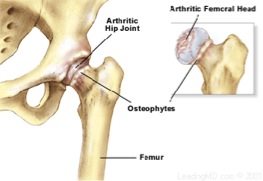Osteoarthritis (OA) is a condition affecting the cartilage of a joint. The role of cartilage within a joint is to act as a shock absorber to protect the bone and provide a smooth surface for a joint to glide. When OA is present, inflammation affects the cartilage and leads to breakdown of the joint surface and cause pain, swelling and joint deformity.
What are the symptoms of OA of the hip?
Symptoms may include pain around the joint when weight bearing. This often presents as deep buttock pain, pain the side of the hip and/or pain in the groin region. Other symptoms may include decreased flexibility and joint stiffness, and clicking, grating or locking.
What causes hip OA?
Hip OA can be described as primary or secondary.
- Primary OA is a generalised OA and often has a genetic link
- Secondary OA is due to previous trauma to the joint. This can be a direct trauma such as a call or car accident, or repeated trauma over time that may relate to work or sporting activities
Risk factors for OA include:
- Older age
- Genetics
- Previous hip joint injuries or joint deformities
- Obesity
- Sex (women have higher rates of hip OA compared to men)
How is hip OA diagnosed?
Diagnosis of OA is based on the individual history and a physical examination of the hip. The groin and lumbar region may also be examined to exclude other conditions and diagnosis can be assisted by getting a plain radiograph of the hip (i.e. X-ray). Many individuals may find OA changes on imaging; however, it is important to determine whether these changes are symptomatic.
Treatment for hip OA
Physiotherapy for OA is targeted at strengthening the muscles around the joint to hip to improve the musculature support around the joint, as well as the joint mechanics. Activity modification is often included to help the minimize pain and symptoms, as well as preserve the joint and slow progression of the disease.
Strengthening of the hip musculature can be completed in a variety of settings. Patients are often prescribed home exercises or may prefer to participate in supervised group exercises classes or hydrotherapy. Weight reduction may also be advised is appropriate.
Individual treatment programs are created to enable self-management and long term control of OA symptoms. In severe cases where conservative treatment has been unsuccessful a hip replacement may be indicated. If a specialist opinion is required we can refer you to one of our preferred hip Specialists. In some cases of more advanced OA, a specialist may discuss the role of various surgical options, including a hip joint replacement.
Physica physiotherapists can assess you hip and create an individualized treatment plan to ensure the best outcome.

